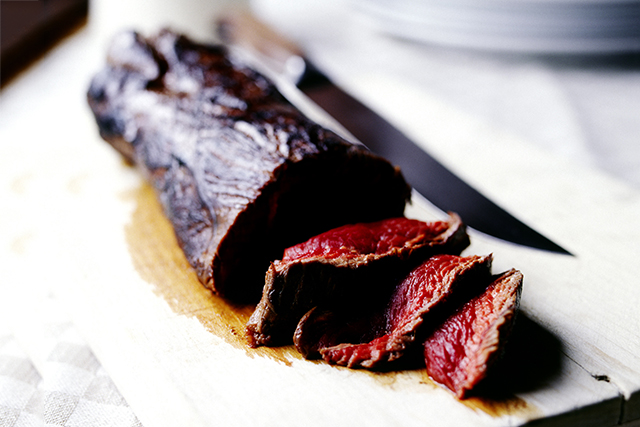It was for an art project, something Damien Hirst-esque, the organ floating in a jar of alcohol in the window of the art gallery space we had during high school in a small Iowa town. The meat department at Hy-Vee dealt with pre-packaged cuts, and beef heart doesn't play quite as well as double-cut pork chops in my hometown. But the woman behind the counter enthusiastically offered up the deer heart that was sitting in her freezer back home.
The price for the butcher paper-wrapped organ, surprisingly small and un-heart-like in appearance? Free. Which makes sense for a hunk of venison that's far less desirable than, say, the tenderloin. But even if the butcher lady had been passing us a prime cut from the deer her husband felled across the Hy-Vee counter, it would have been illegal to sell.
In fact, the sale of any and all wild game is banned in the United States, and has been for more than a century. But with whitetail deer populations booming, some are saying its time to bring back commercial hunting as a means of conservation-minded population control.
The concept, presented at the Wildlife Society's annual meeting in Milwaukee earlier this month, is gaining a small amount of momentum among scientists in the conservation community, Jim Sterba writes for the Wall Street Journal.
"The new incentive would involve targeting overabundant whitetails in specific places - neighborhoods, parks, greenbelts, townships - for tightly controlled culls by specially qualified shooters," he writes. "Hired sharpshooters already perform this task in many places, at taxpayer expense. The difference is that, instead of being donated to food pantries or sent to landfills, the venison and byproducts could be sold, perhaps as a locavore delicacy, to recoup some costs."Despite the annual fears expressed by the friends with hunting fathers, that they would go to get the car out of the garage only to find a split buck hanging from the rafters, licensed killing of game like whitetail deer do little to keep populations in check. Commercial hunting had nearly wiped out deer and other game in 1900, when the landmark conservation bill known as the Lacy Act was passed, protecting game and wild plants from being exploited for financial gain - and the so-called North American conservation model has been wildly successful.
With deer finding life mighty comfortable in suburbs and exurbs, where there's plenty of landscaping and backyard gardens to munch on, much to homeowners chagrin, and increased populations even threatening their own natural forest habitat, the achievements of conservation has officially turned a once-threatened species into a omnipresent pest.
Hunting licenses will allow six million whitetail deer to be killed this year, and the entire population is estimated to be somewhere between 30 and 45 million - up from just 350,000 in 1900. By comparison, 34.1 million head of cattle were slaughtered in the U.S. in 2011, according to USDA's Economic Research Service. So it's not like the legal sale of game, no matter how large the program, could turn the U.S. into a factory-farm-free utopia fed on lean, largely ethical meat, raised in unconfined, natural conditions.
But considering that nearly every plate of venison medallions served alongside local produce in the United States was raised on a farm in New Zealand, deer killed in the same woods where the morels are hunted for could be a major draw in today's dining scene.
So what's stopping game conservationists from sending out the hired guns and filling paperwork with farmers' markets and reaching out to local foods-minded chefs?
Well, there's the lead to consider, for one. In 2008, the Centers for Disease Control found that consuming wild game like venison can increase the amount of lead in the body of diner by as much as 50 percent. The CDC suggested that "all nonessential uses of lead should be eliminated" in 2005. But despite the new California law banning lead ammunition, its unlikely that buck shot, so prevalent in deer hunting that the tiny bullets take their name from it, won't be fashioned from the heavy metal anytime soon.
And despite conversations like the one held in Milwaukee, the conservation community is by no means sold on the idea. Sterba quotes a statement from the Wildlife Society panel, written by retired deer expert James E. Miller, that reads,
"I find it repulsive to even consider the idea of demoting game wildlife species to the status of domestic livestock to be exploited, sold or bartered for personal gain."The Lacy Act enshrined a rather beautiful idea, that wildlife is held in the public trust, tasking the government with protecting these natural resources for future generations. Opening them up to a commercial market - even a highly regulated one - could be seen as a fundamental violation of that responsibility.
It's a debate that will take quite a while to hash out. So in the meantime, I suggest you get friendly with someone who works at the meat counter of a small-town supermarket if you want to get your hands on some local venison without having to pick up a gun yourself.




Reader Comments
to our Newsletter